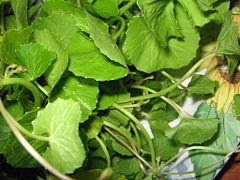
ONE should not look down on the humble herbal industry in Malaysia, which of late has been attracting steady interest both in terms of consumers and investors following a global resurgence in the usage of traditional and complementary medicine (TCM) treatment versus modern medicine.
Local herbs and plants that thrive in our backyards and rainforests and increasingly making their mark internationally include kacip fatimah (labisia pumila), pegaga (pennyworts or centella asiatica), peria (bitter gourd), misai kucing (cat whiskers), mas cotek (mistletoe fig), limau purut (kaffir lime), tongkat ali (Eurycoma longifolia Jack) and jambu batu (guava).
Pegaga is currently vastly commercialised for its antibiotic properties that support the immune system and is especially beneficial in treating a variety of skin problems.
Tongkat ali, meanwhile, is one of the most expensive herbal plants sold on the market and for good reasons too given its nickname as nature’s testosterone booster.
The shrub is very rare and some said searching for tongkat ali in the Malaysian jungle is akin to searching for truffles in France or Italy.
At the same time, many herb-based industry players are exploring ways to merge various herbal cosmetics, healthcare and services, biotechnology, food and natural medicine into a single tourism product.
Apart from direct herbal manufacturing operations, new market segments could be developed including home spas, herbal clinics and pre-and post-natal care using local herbal products.
In fact, the thriving herbal industry in Malaysia is expected to reach almost RM10bil in 2009 and likely to grow 8% to 15% annually in line with the growing acceptance for herbal based natural phyto-medicine globally.
The World Bank has also estimated that the global market for herbal-related medicinal products is poised to escalate to US$5 trillion in 2050 from about US$200bil in 2008.
Capturing 1% of the global market share by then could easily translate into a RM190bil industry for Malaysia!
Taking these facts into account, Malaysia is doubling its effort to position itself as a “rainforest herbal hub” where local and foreign companies can conduct research to develop more TCM products for healthare and other related applications.
At the same time, since early 2000, the Government has set up the Malaysian Herbal Corp (MHC) under the Ministry of Science, Technology and Innovation (MOSTI).
MOSTI also has three biotechnology institutes, namely Malaysia Institute of Pharmacetical and Nutraceutical, Malaysia Genome Institute and Agrobiotechnology Institute to work synergistically with industry players to lead the industry to greater heights.
Given that Malaysia’s rich flora and fauna support over 20,000 plant species, of which 2,000 plant species have been identified to have medicinal value, it is worthwhile for herbal-based industry players to seriously look at this thriving business opportunity.
Why not take advantage of the current mounting interest in natural product remedies as more and more people are becoming concerned over the side effects caused by synthetic drugs, the rising cost of healthcare and the failure of mainstream medicine to treat certain diseases? - Hanim Adnan, theStar







